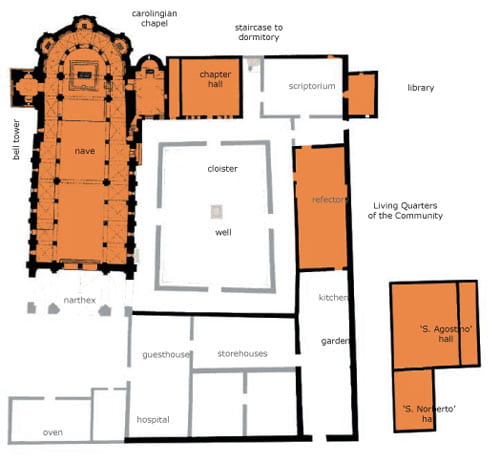Source: Plan of the abbey of St. Antimo, taken verbatim on 24 September 2013 from the following cached version of a webpage that is no longer available: http://web.archive.org/web/20060511010812/http://antimo.it/pagine_en/07_riquadro_piantina.html
the plan of the monastery

Even if they differed in measure, complexity, and use of materials, all the monasteries built by the Benedictines in medieval Europe – in Galicia as in England, in Switzerland as in Burgundy, in Lombardy as in Normandy – had at least one point in common: the plan.
The church, with its apse orientated towards the east according to the liturgical custom, nearly always has a cloister adjoined on the southern side (the old Roman atrium) with a covered gallery or passageway on all four sides.
In the east gallery of the cloister, parting from the church, the sacristy, the treasury, the chapter hall, the staircase leading to the upper floor, and the ‘scriptorium’ (with a large fireplace), are found. On the upper floor is the monks’ dormitory, frequently connected to the church in order to allow the monks ready access for nocturnal prayer. Along the gallery on the south of the cloister – directly opposite the church – the refectory, often furnished with a fountain, is collocated. The kitchen is situated on the corner where the south wing encounters the west wing, and gives access to the refectory on one side, and to the exterior on the other side. The storehouses and pantries are generally situated on the western side, while the dormitory of the laymen is found on the upper floor. Also rooms for guests or pilgrims, an infirmary, and other buildings – where the monks could work – were built near the monastery.
The actual structure is designed in black, while the hypothetical reconstruction of the destroyed sections are designed in grey.